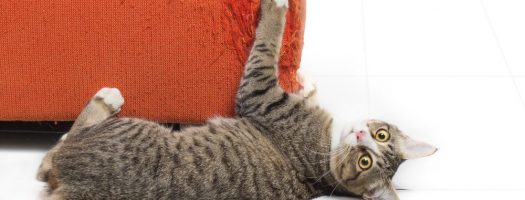The 10 Best Self-Cleaning Litter Boxes to Buy in 2025
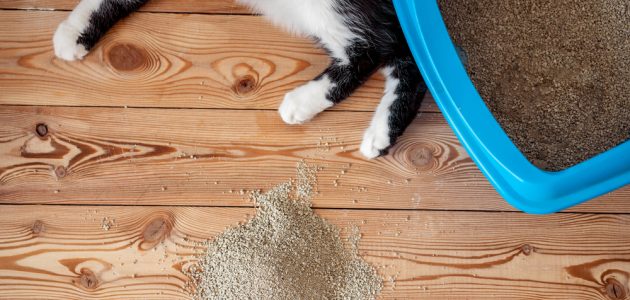
Cats are known for being clean, well-groomed, and low-maintenance pets. In fact, cleanliness is part of the reason kitties are one of our most beloved home companions – along with being cute, playful, and perfect .gif material.
Unfortunately, it’s not all pawing and purring, and if your feline friend is unhappy with their litter box, they may (quite literally) kick up a stink in your home. Even if your cat is content, who’s to say you are? Nobody dreams of spending their downtime cleaning cat poop.
Thankfully, there are now innovative litter box designs on the market that can take the scooping out of pooping. These self-cleaning litter boxes remove the need for scooping entirely, can help reduce the unpleasant odor of animal waste in your home, and even offer health benefits for both you and your cat. When it comes to choosing the perfect box, there’s lots of info to get your paws into; let’s start with factors to consider in your buying decision.
- Factors to Consider When Buying a Self-Cleaning Litter Box
- Top 10 Best Self-Cleaning Litter Boxes 2025
- 1. Best Overall Self-Cleaning Litter Box: PetSafe ScoopFree Ultra
- 2. Best Open-Top Self-Cleaning Litter Box: PetSafe ScoopFree Automatic
- 3. Best Premium Self-Cleaning Litter Box: Litter-Robot 3 Connect
- 4. Best Rolling Self-Cleaning Litter Box: Omega Paw
- 5. Best Budget Self-Cleaning Litter Box: PetMate Sifting Pan
- 6. Best Anti-Spill Self-Cleaning Litter Box: SpeedySift
- 7. Best Zero-Maintenance Self-Cleaning Litter Box: CatGenie
- 8. Fastest Self-Cleaning Litter Box: Le You Pet Semi-Automatic
- 9. Best Odor Control Litter Box: LittleMaid Single Cat
- 10. Best Extra Large Litter Box: LittleMaid Multi Cat
- Guide to Buying the Best Self-Cleaning Litter Box
- FAQs
- Self-Cleaning Kitty Litter: Welcome to the Future
Factors to Consider When Buying a Self-Cleaning Litter Box
This guide includes a range of self-cleaning litter box choices to satisfy cat owners in all circumstances. But whether you’re after an electronic device with all the bells and whistles, or a simple system to make changing litter quicker, there are some common factors you should look out for. Here’s what we deem most important for a well-informed purchasing decision:
Type of Self-Cleaning Litter Box
There are three types of self-cleaning litter boxes: automatic, rotational, and manual.
Automatic Litter Boxes
Automatic litter boxes are typically powered by electricity and do almost all the work in separating litter. They’re the most hands-off but most expensive.
Rotational Litter Boxes
Rotational litter boxes usually rotate with a handle, sorting waste from litter with a simple twist of the handle. They’re a bit more labor intensive but they don’t rely on outlet power.
Manual Litter Boxes
Manual litter boxes use a screen, sieve, or grille to separate waste from soiled litter, although they do require a little bit of dirty look and more frequent effort than automatic litter boxes.
For a more detailed breakdown of these different types, how they work, and which option may be best for you, skip over to our Self-Cleaning Litter Box Designs section. Our product reviews also specify the cleaning mechanism for each product, as well as detail exactly how this works.
Waste Removal
Automatic options use detection sensors to clean the litter box once your cat has done their business. Some only require you to remove waste once the storage receptacle is full – which could be 7+ days. Manual self-cleaning options rely on your nose for detection, and although you can wave goodbye to the days of scooping, these still require you to remove waste regularly.
Litter Required
Several boxes require a special type of cat litter and where this is the case, we’ve noted it in our reviews. For most cat owners, switching the type of litter shouldn’t be a problem, especially if you follow our advice for introducing a new litter box But for those with fussy felines, changing litter type may not be worth the risk of disrupting their habits. Specialist litter can also come at a premium and should form part of your pricing considerations.
Size
Cats can be very picky about where they poop. In fact, experts recommend your litter box is 1.5x the size of your cat, so you’ll need to plan accordingly. For those with more than two cats, you’ll want an option specially designed for multi-cat homes so that soiled litter isn’t an issue.
Noise
Cats are easily spooked, especially during bathroom time when they feel vulnerable. If your cat is the type to dart for the exit when a vacuum is switched on, you may wish to consider quieter options as some automatic litter boxes are pretty loud.
Odor Control
Perhaps you landed here in the quest for a solution to the ever-present smell of cat poop that seems to permeate your home. If so, the ability of a litter box to effectively contain foul odors is essential.
Installation & Maintenance
Self-cleaning boxes make dealing with litter a breeze. But if you need to spend this saved time maintaining the box itself, is it worth it? Manual models are typically easier to maintain, especially for technophobes.
Top 10 Best Self-Cleaning Litter Boxes 2025
1. Best Overall Self-Cleaning Litter Box: PetSafe ScoopFree Ultra
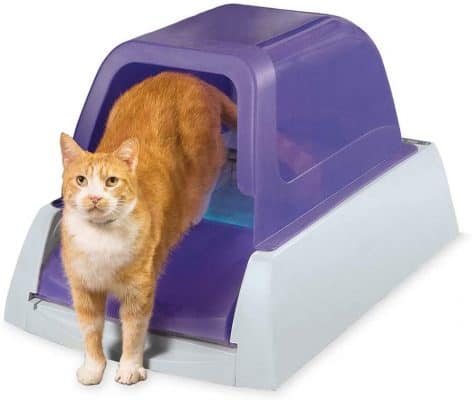
Editor’s Rating:
Why we like it: With automated (and variable) cleaning cycles, a ‘health tracker,’ and highly absorbent crystal litter, the ScoopFree Ultra is the best all-around self-cleaning litter box we’ve seen.
Quick Facts
- Type: Automatic
- Variations: Purple or taupe colors, as well as a top-entry version
How It Works
ScoopFree Ultra uses sensors to detect your cat entering and exiting the box. Then, after a predetermined time (you choose either 5, 10, or 20 minutes) the automatic cleaning cycle begins. The waste is then raked from the specialized ‘crystal litter’ and into a waste compartment, leaving the remaining litter fresh for reuse. An automatic ‘health tracker’ counts the number of times the box was used since the last clean, and no daily litter removal is required.
Waste Removal
The waste is raked into a separate compartment, and thanks to the odor-absorbing crystals, rake system, and box hood, any faint smell is well contained enough for you to go days before removing. According to PetSafe, you should monitor the health tracker and change the litter crystals either after 30 days or 100 rakes (whichever is first). To do so, you simply place the lid onto the disposable tray and then bin it. This is easy to do, but in our experience, cleaning after 70-75 rakes is preferable, as things can start to smell as you approach the maximum limit. Still, this level of performance is stand-out.
Litter Type
The non-toxic crystals do an excellent job of absorbing urine and moisture from feces. You’ll have to stick to this special litter though, as other types can damage the raking mechanism. Crystal litter is sold in replacement trays and while these aren’t cheap, you’ll still save money in the long-term as you’ll need to replace the litter so infrequently.
PRO-TIP: as the specialized crystals absorb moisture, it’s better not to place the litter box in a high moisture area, like your bathroom.
Size
For most standard cats, this box is perfectly sized. It’s big enough to be comfortable for your pet while not taking up excessive space in your home. Plus, as long as your cat’s not too fussy, you can take off the removable privacy hood and save even more space. Doing this is great for larger cats too, giving them even more space to get comfortable.
Noise Level
The ScoopFree Ultra is surprisingly quiet, and we consider it safe for even the most timid cats. In fact, the Ultra is strikingly quiet when compared to the Litter-Robot 3, despite the latter being a premium device costing significantly more.
Odor Control
This model allows you to choose how long after use you want litter to be raked. The longer you wait the more moisture can be absorbed from the litter, making it easier to rake. As such, we suggest you start at the max time (20 mins) and drop this down if you notice an unpleasant odor.
PRO-TIP: The storage area for the cat waste isn’t sealed, but as long as you add some litter into the poop tray when you clean it, it will remain dry and give off no noticeable smell.
Installation & Maintenance
Occasionally, you may find you need to clean the raking track when it gets stuck. Generally though, we find this to be a very reliable product and it comes with a 1-year manufacturer’s warranty. Unfortunately, the disposable trays are made from cardboard, and cats that like to dig may well scratch through them. There is a solution, the ‘forever tray,’ that utilizes permanent materials, but it’s an add-on purchase. Admittedly, it works great, but we would have liked to see this included as standard.
Pros
- Requires very infrequent waste removal
- Fully automated with variable cleaning cycles
- Specialized litter effectively absorbs moisture and odor
- Innovative health tracking counter to monitor usage
- Comes with removable privacy hood
Cons
- Requires use of specialized litter
- Some cats may scratch through disposable trays
2. Best Open-Top Self-Cleaning Litter Box: PetSafe ScoopFree Automatic
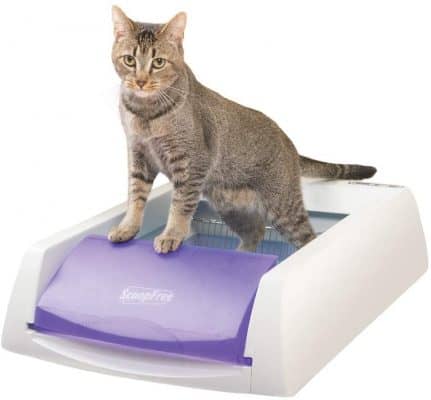
Editor’s Rating:
Why we like it: Highly effective and low-noise, automated cleaning makes this the perfect device for cats who like an open-top box, and for owners who like to take the stress out of litter duty.
Quick Facts
- Type: Automatic
- Variations: Purple or Taupe colors and a newer ‘2nd generation’ model
How It Works
This device is the little brother to the ScoopFree Ultra and there are only three differences between the two. Firstly, with the ScoopFree Automatic, the cleaning cycle commences after 20 minutes, and there is no option to change this. If your cat’s waste is particularly offensive-smelling, you may find this duration a little long, but there’s always a button you can press to start the process immediately. Secondly, this model has no ‘health tracker’ to count how often it’s used. We find this feature useful for monitoring the health and habits of your kitty, as well as prompting you to change the litter. Finally, this option does not have a privacy hood like the Ultra does.
Waste Removal
In terms of waste removal, the ScoopFree Automatic is identical to our best overall pick, the ScoopFree Ultra. Both offer a highly significant reduction in waste removal, even when compared to the very best manual self-clean options, which still require daily attention.
Litter Type
As with the ScoopFree Ultra, specialized litter crystals are required. These crystals don’t stick to cat paws as many cheaper litter types can, and while there are better ‘non-tracking’ litters out there, we’ve not seen one that can also absorb odor this well. Plus, with the crystal litter there’s no ‘litter dust’ generated, so your home stays cleaner, too.
Size
The ScoopFree Automatic gets full marks for size. As with the Ultra, it’s large enough to accommodate most cats, without being a giant eyesore in your home. In fact, as there’s no hood on the Automatic, this version takes up even less space.
Noise Level
As their inner mechanisms are identical, the noise level is identical to the ScoopFree Ultra. We consider the (lack of) noise during cleaning to be the best on the market.
Odor Control
Odor control doesn’t quite match the ScoopFree Ultra, which we expect is due to the hood helping to contain the stench. But thanks to the crystal litter, odor is remarkably well contained, making this is a great choice for those with a keen sense of smell.
Installation & Maintenance
Rakes are the most common failure point, but if you deep clean the prongs once per month, you should be fine. To reduce monthly maintenance time further, you can purchase an (expensive) forever tray which, for the already-high price of the standard litter box, feels like an upgrade that should be included.
Pros
- Fully automated cleaning requires infrequent manual work
- The specialized litter is low tracking
- Surprisingly quiet cleaning
Cons
- Requires the use of specialized litter
- The add-on ‘Forever tray’ is a pricey extra
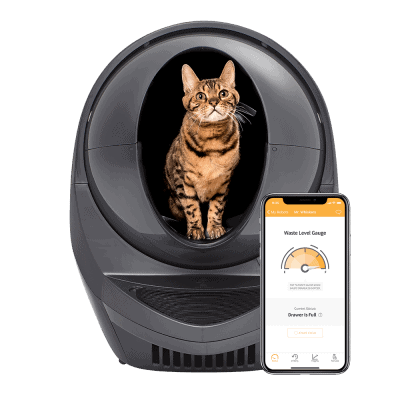
Editor’s Rating:
Why we like it: The Litter-Robot 3 has every feature you can imagine, and then some. It’s by far the most comprehensive and technologically advanced offering on the market, ideal for those who don’t mind its premium cost.
Quick Facts
- Type: Automatic
- Variations: Beige & Grey Colors
How It Works
Does the Litter-Robot 3 look more akin to a futuristic cyborg than a litter box? Absolutely. But it works. Rather than raking, the litter box ‘globe’ rotates after your cat uses it and moves all the waste into a separate receptacle. It also offers additional features like a sleep mode and a night light that no other self-cleaning litter box on the market offer. Plus, both usage and waste-buildup can be monitored via push notifications from a WiFi-enabled app.
Waste Removal
After use, cleaning happens automatically on a self-selected 3, 7 or 15 minute delay. When the waste receptacle is full (which can take an impressive 7 days), you’ll be notified via the app. Only the ScoopFree Ultra offers a similar level of cleaning customization.
Litter Type
Many self-cleaning litter boxes require you to use their proprietary branded litter and it can be tough to tell if this is truly a necessity or more of a marketing ploy. With the Litter-Robot 3, a clumping litter is required, but beyond that, the choice is yours. The cleaning mechanism is very efficient, and you’ll use much less litter than with every other option we reviewed.
Size
With all the features offered, it’s no surprise that this box takes up a lot of space. For this reason, it’s certainly not ideal for smaller homes and we advise you to make sure you have the necessary space before you make the hefty investment. That said, this box is excellent for large cats, as it has a wide opening (15.25 x 10.25 inches), and will hold up to a whopping 20lbs of feline.
Noise Level
Despite its claims of quiet operation, we find the cleaning process is actually quite noisy. So expect it to take some time for your kitty to adjust. Still, there’s no concern about it keeping the family up at night, as the unique sleep-mode can delay the next cleaning cycle until morning.
Odor Control
An indicator light shows when it’s time to clean (as well as an optional app notification), so you needn’t worry about constantly opening the receptacle to check. As such, odor is well contained right up until removal, and only the LitterMaid Single Cat and the LitterMaid Multi Cat do a better job.
Installation & Maintenance
Set up is quick and painless, surprising when you consider the depth of functionality. We also find it to be very reliable, with a robust cleaning system that rarely falters. Plus, it comes with an 18-month warranty, which is a nice touch. Of course, this all comes at a premium. It’s by far the most expensive box to make our list costs over 25 times as much as our favorite budget pick, the PetMate Sifting Pan.
Pros
- Fully automated cleaning, with app control and waste removal notifications
- Requires much less litter than competitors
- Comes with an 18-month warranty
Cons
- Premium price tag
- Takes up a lot of space
4. Best Rolling Self-Cleaning Litter Box: Omega Paw
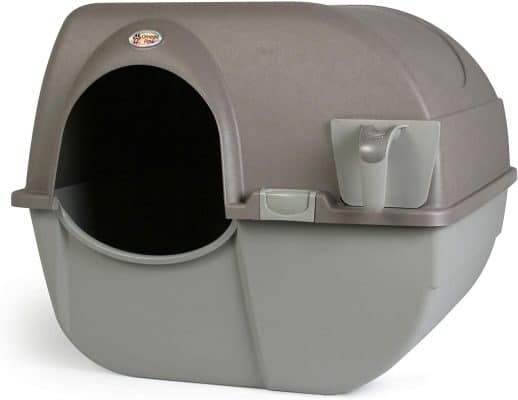
Editor’s Rating:
Why we like it: The simple rolling mechanism is highly effective and provides an alternative, no-frills solution to getting your hands dirty, as well as a nice protective space for your cat.
Quick Facts
- Type: Rotational
- Variations: Regular or Large sizes and in a choice of Pewter, Midnight Black or Forest Green color schemes.
How It Works
The Omega Paw has a protective box shape that provides a spacious and covered environment for your little friend. Once your kitty has done their magic in the tray, you can manually roll the box onto its topside and then back to the upright position. As you do this, the grille inside the box filters out clumped waste and deposits it into a pull-out tray. It’s not totally hands-off, like the ScoopFree Ultra, but it’s much quicker than sifting with a tool.
Waste Removal
After rolling, waste is moved into a separate compartment. You’ll need to roll daily to maintain a clean litter environment for your cat to use again, but you don’t have to remove the waste from the compartment immediately. Of course, the sooner the better, but the waste compartment gives you a degree of freedom you wouldn’t get with a manual litter box.
Litter Type
Each time you roll the box, you’ll want to add an extra small cup of fresh litter back in. Any ‘clumping’ litter can be used, so there’s a good chance you can continue using your kitty’s favorite brand. If your cat’s not fussy, this also gives you the chance to experiment with the most cost-effective litter options, which we see as a big bonus.
Size
Bear in mind you will need some space to roll the device across the floor, so it’s not best suited for those with limited floor space. You’ll need about 1.5 square meters to get the job done comfortably.
Noise Level
When rolling, you are effectively hitting the litter against the grille mechanism to separate it from the waste. As you might expect, this is pretty noisy. But as there’s no automatic rolling, you can do this on your own time and you needn’t worry about disturbing your cat as they do their business.
Odor Control
There’s no special odor control, but the separation of waste from the main litter does help a little. Overall, the Omega Paw won’t prevent odor like the automatic versions we reviewed but is much better than sifting options, which leave soiled litter in the open until attended to.
Installation & Maintenance
The box is a breeze to assemble and once you add in your choice of clumping litter, you’re good to go. There’s nothing much else to attend to – just add small amounts of fresh litter after every roll, and a full clean and change each month.
Pros
- Simple but effective rolling mechanism
- Quick assembly
- Provides a protective environment for your kitty’s comfort
Cons
- Litter box requires space for rolling
- No odor control
- Can be noisy when rolling
5. Best Budget Self-Cleaning Litter Box: PetMate Sifting Pan
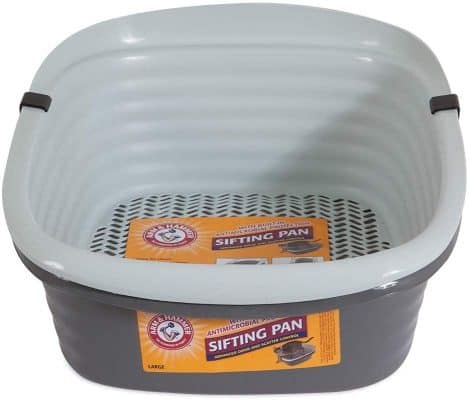
Editor’s Rating:
Why we like it: There’s a genius in simplicity, and while the PetMate Sifting Pan may look more like a regular litter box, it’s highly effective at sifting litter quickly and with minimal mess.
Quick Facts
- Type: Manual
- Variations: Grey or Storm Grey colors
How It Works
This litter box comes with 3 pans: one sifting option and two standard pans. You fill one pan with litter and after your cat has done their business, you pour the contents of the dirty pan into the empty pan, with the sifting tray placed inside. You then simply lift the sifting tray out of the second pan, and you’re left with clumps of soiled litter to dispose of.
Waste Removal
While significantly more convenient than truly manual litter removal (as there’s no searching and scooping required), there is nothing automated here. Still, the sifting pan is very effective for its purpose and does a surprisingly good job of quickly filtering the poop from the litter inexpensively.
Litter Type
Most litter types can be used and this is one of the few products reviewed that does not require clumping litter. We consider this to be a big advantage, especially for owners of fussy-cats who are prone to go elsewhere with the slightest of changes.
Size
This box won’t take up much space and is a great step up from manual scooping for those concerned about space requirements. The downside to this is that as the box edges are low, making it easier for messier cats to kick out litter.
Noise Level
Sure, the sound of litter being passed through the pan is audible, but it’s not enough to cause a disturbance to the cat or family and is much quieter than most automatic boxes.
Odor Control
The box itself does nothing to control odor and it’s open-top nature makes it worse than others at containing bad smells. Certain litter types may help reduce this smell slightly, but if the stink is your main qualm with your current litter box, you’ll want to skip this option.
Installation & Maintenance
As a budget pick, this is the least advanced litter box to make our list. Still, no automation means there’s nothing to install and nothing to maintain. If you’re simply looking to speed up the time litter cleaning takes each day, this may be perfect for you.
Pros
- Comparable in cost to a regular litter box
- No lengthy installation of maintenance
- Can use most litter types
- Quieter than automatic boxes
Cons
- Still requires daily sifting
- No odor control
6. Best Anti-Spill Self-Cleaning Litter Box: SpeedySift
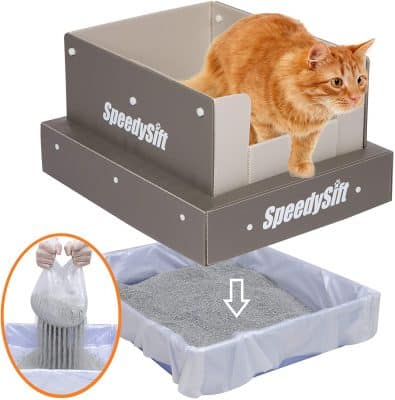
Editor’s Rating:
Why we like it: The unique lining design and high-walled sides make this the ideal box for those with messy cats who like to spread litter all over the room.
Quick Facts
- Type: Manual
- Variations: N/A
How It Works
Like the PetMate Sifting Tray, SpeedySift also requires ‘sifting’ to sort the litter from the poop, but rather than plastic trays, it uses disposable liners within a high-walled plastic box. The holes in the sifting liners are designed as an offset array between layers, meaning if your cat catches a claw in one of the holes, it only tears through one liner, and not the whole stack.
Waste Removal
While there’s no scooping required, you’ll need to remove the waste manually as often as necessary. More likely than not, this will be daily. Still, the liners make this a breeze and it’s significantly quicker than manually scooping.
Litter Type
You’ll need to use non-lightweight, clumping clay litter for the best results. The good news is there’s no requirement to use a specific brand, and the savings from buying more economical litter can really add up over time.
Size
We love the high-walled design of the box, which helps prevent litter from escaping and wall spraying. The lightweight plastic also keeps this box very light, so occasionally moving it between rooms is no hassle at all, which can’t be said for many automatic devices we’ve reviewed.
Noise Level
As well as being much quieter than automatic options, the unique stacked liner, sifting design also makes this quieter than sifting plastic trays. If you’re looking for a quiet manual option, this wins out over the PetMate Sifting Pan.
Odor Control
There’s no built-in odor control so any protection against foul scents will come solely from the litter you choose and the frequency of litter changes. The smell-sensitive should consider more expensive automated litter boxes!
Installation & Maintenance
The clever liner design makes the SpeedySift very easy to set up and maintain. It only takes 2 seconds (literally) to clamp 15 liners into place, so outside the daily sifting, maintenance is minimal. The sidewalls of the box can also be replaced if your cat has a frustrating tendency to soil the walls repeatedly. These do come at an additional cost though, which is a shame as the litter box itself usually runs over $50 – expensive for the fact that it still requires daily effort.
Pros
- High-walled box prevents litter spillages
- Liner replacement is incredibly quick
- More portable than other self-cleaning boxes
- Compatible with most litter types
Cons
- Expensive for a manual option
- Still requires daily sifting
- No odor control
7. Best Zero-Maintenance Self-Cleaning Litter Box: CatGenie
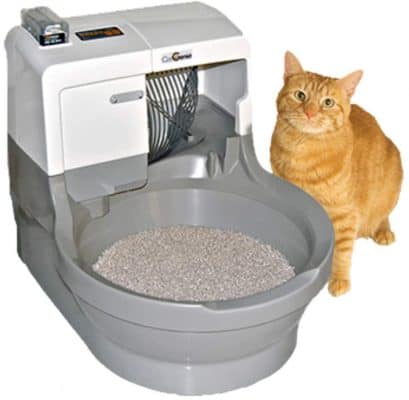
Editor’s Rating:
Why we like it: Nothing competes with the CatGenie when it comes to waste removal. The premier option for truly automated poop disposal.
Quick Facts
- Type: Automatic
- Variations: Standard or I version
How It Works
The CatGenie works more like a regular toilet than a litter box, a fact that’s reflected in its premium cost. It needs to be hooked up to cold water and an electric outlet, as it liquefies solid waste, flushes it, and then decontaminates the bowl automatically. Here’s how it works:
Waste Removal
CatGenie is the only litter box system available that doesn’t require any manual waste removal. It self-flushes, self-cleans, and then self-dries. Impressive stuff. In terms of waste removal, no other product we’ve reviewed comes close.
Litter Type
CatGenie uses washable granules rather than conventional cat litter. These granules are an essential part of the system, but as they’re washable you won’t need to buy frequent replacements. As such, you can expect huge long-term savings as traditional kitty litter becomes a thing of the past.
Size
If you have space, the CatGenie is excellent for the most hygiene-conscious cat lovers, but it’s big and bulky, so don’t expect it to go unnoticed in the corner. Ultimately, a large device is necessary for a system this comprehensive.
Noise Level
The CatGenie is more like an electrical appliance than a litter box, and this is reflected in the loud sound of clunking, clanging, and swirling during use. As the most likely location for installation is a bathroom or laundry room, this shouldn’t be a deal-breaker.
Odor Control
As the waste is liquefied and disposed of directly into the drainage system, you would expect odor to be a complete non-issue. Unfortunately, the cleaning process itself does cause the device to emit an unpleasant odor. This soon disappears though and seems to be a necessary trade-off for truly hands-free litter removal.
Installation & Maintenance
Without exception, the CatGenie is the most difficult device to install. For most people, it’s likely too much effort for a one-cat home, and problems like clogging can be tricky to solve without professional help. But for households with 2-3 cats, it may be worth the investment. After all, the reward is the complete removal of litter changes from your daily chores.
UPGRADE: CatGenie also offers a more premium, ‘A.I’ version of this litter box. It uses machine learning to more effectively plan cleaning and an app for digital control.
Pros
- Zero manual litter cleaning required
- Doesn’t require purchases of cat litter
- Suitable for multiple cats
Cons
- Requires connection to your home’s drainage system
- Premium price tag
- Can get noisy and smelly during cleaning
8. Fastest Self-Cleaning Litter Box: Le You Pet Semi-Automatic
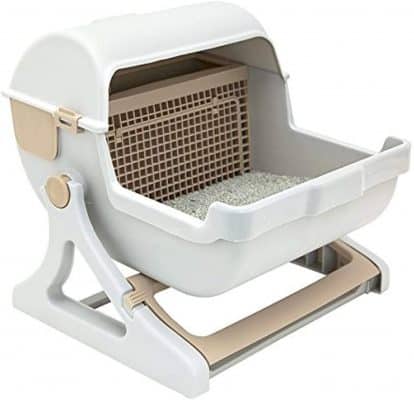
Editor’s Rating:
Why we like it: The Le You Pet Semi-automatic can separate litter from waste in a staggering 7 seconds, without the need of any outlet power.
Quick Facts
- Type: Rotational
- Variations: N/A
How It Works
The Le You Pet system uses a separation grid, within a drawer-style cleaning box. Once your cat does their business, you just lift, flip, and lower the tray. Within 7 seconds the soiled litter will be clumped in a receptacle drawer, ready for removal.
Waste Removal
To remove pet waste, you need to manually remove the litter from a receptacle. This is easy enough to do, and the process is pretty similar to other self-cleaning boxes. Notably though, it’s up to you to monitor how often this is needed. There’s no usage tracker or app notification, like with the more premium automatic options.
Litter Type
Any litter will work, as long as the granules are small enough to pass through the internal grid. A word of warning – if your cat doesn’t bury their poop, the litter won’t absorb the moisture as effectively and as a result, it may not cleanly pass through when flipped. This is worth a thought as cleaning a sticky, poop-covered grid takes away all the convenience of a self-cleaning box!
Size
While the manufacturers state this box can support heavy cats, up to 18lbs, we find it a little on the small side. Larger cats will likely leave a mess as there’s not much room to maneuver. If your cat is anything larger than medium size, there are better options available, like the LitterMaid Multi Cat.
Noise Level
Rotating the box feels and sounds a little clunky, but we can forgive this because it’s over so quickly – a 7-second litter clean is not to be sniffed at!
Odor Control
As an open-top box, if you leave soiled litter in the main tray, it will smell. But we find the smell is well contained once the waste has been moved into the receptacle, and this is convenient for when you don’t have the time to remove the waste immediately. You can just rotate the box to contain the stink, and get back to it later.
Installation & Maintenance
It arrives completely disassembled, but we expect most people could put it together in under 10 minutes. Unfortunately, the parts feel cheaply made and it’s not uncommon for bits and pieces to split or bend out of shape with repeated use. As a sturdier alternative for this rotational device, the Omega Paw feels much more sturdy.
Pros
- Rotational cleaning is very quick
- Can separate soiled litter without needing immediate removal
- Compatible with most litter types
Cons
- Parts feel cheaply made
- Not ideal for cats that don’t bury their litter
- Too small for larger cats
9. Best Odor Control Litter Box: LittleMaid Single Cat
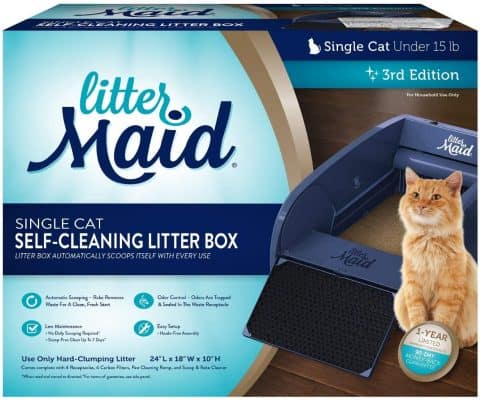
Editor’s Rating:
Why we like it: The LitterMaid Single Cat’s carbon filter does a phenomenal job of controlling foul odor, meaning you only need to remove waste every 5+ days.
Quick Facts
- Type: Automatic
- Variations: N/A
How It Works
This litter box automatically rakes itself after every use, and a waste receptacle and carbon filter keep the odor contained until it’s ready to be emptied. Cleaning starts after 20 minutes after use, similar to the ScoopFree Ultra.
Waste Removal
This box is advertised to last up to 7 days before waste removal but 5 days is more realistic. Still, we consider this to be a top-performing device in this category.
Litter Type
Hard, clumping litter is suggested. Unfortunately, we find that performance varies wildly between different litters and you’ll probably have to try several different options to find one that works effectively. Typically, lighter litter is raked well but is prone to tracking out of the box. Heavier litters stay in the box but tend to stick to the rake mechanism. If your cat is very picky with the litter they’ll use, this could be an issue.
Size
The LitterMaid Single Cat is on the small side and is not suitable for larger cats (think those close to 15lbs), or multi-cat homes. Thankfully, LitterMaid does offer a Multi Cat option, which also makes our list.
Noise Level
Unfortunately, this box is pretty noisy. It sounds similar to a hairdryer when operating and more timid cats may find this a little intimidating.
Odor Control
The waste receptacle has a tight seal and uses carbon to control odor, which is very effective. Smell is a complete non-issue when using the LitterMaid, and for some, this may be worth the hassle of finding a suitable litter type initially.
Installation & Maintenance
Over the long-term, you may find the raking system is prone to clogging and that weekly cleaning becomes necessary. Overall, you should expect to spend more time maintaining this box, than you would with the other products we’ve reviewed.
Pros
- Automated cleaning begins 20 minutes after use
- Only requires waste removal every 5 days
- Carbon filter gives excellent odor control
Cons
- Too small for many cats
- Device is louder than most competitors
- Can be hard to find a compatible litter
10. Best Extra Large Litter Box: LittleMaid Multi Cat
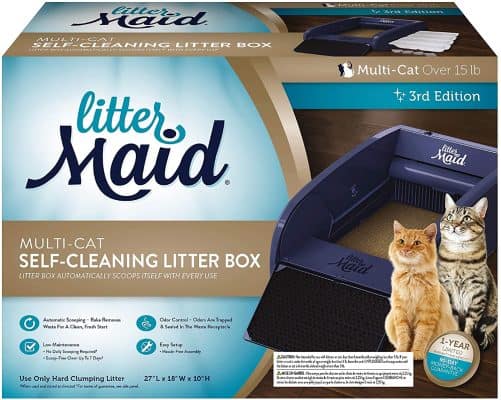
Editor’s Rating:
Why we like it: Specifically designed for large cats and those living in a multi-cat home, this product means you’ll no longer need multiple litter boxes positioned around your home.
Quick Facts
- Type: Automatic
- Variations: N/A
How It Works
LitterMaid Multi Cat works identically to the LitterMaid Single Cat, using an automated raking device that self-cleans after each use. It feels significantly stronger and better-powered though, and we consider this version much more durable.
Waste Removal
If you only have one cat, you may find you can go a day or two longer between waste removals than with the LitterMaid Single Cat. Generally though, we still see every 5 days as a realistic, and impressive timeframe.
Litter Type
As with the LitterMaid Single Cat, the biggest issue with this litter box will probably be a difficulty in finding litter that is raked without clogging. It’s best suited for non-fussy cats who will do their duty just about anywhere and won’t mind if you’re switching between a selection of different litters while you search for a good match.
Size
This box will easily accommodate multiple large cats. Typical recommendations are to have more litter boxes than cats in your home, but choose the LitterMaid Multi Cat and you’ll only need the one device. That said, it’s quite shallow, and even adding the humane-society recommended amount (a 2-inch depth) makes it prone to spills.
Noise Level
There’s no debate to be had here, this is the loudest litter box to make our list. If your cat’s the type to be spooked by a printer or vacuum, this isn’t your best option. Consider the stealthier ScoopFree Ultra instead.
Odor Control
The carbon filter makes odor prevention excellent. This box scores very highly against the competition and is well-suited for those who prefer to avoid the bathroom smells of their feline friend.
Installation & Maintenance
Similarly to the LitterMaid Single, the system comes with a helpful rake-cleaning solution and a scoop to help you maintain the box appropriately. While the cleaning solution is a nice bonus, the inclusion of a scoop perhaps says more about the expected performance – you are trying to avoid scooping, after all.
Pros
- Can accommodate large cats
- Excellent odor control, due to carbon filter
- Only one box required even for a multi-cat house
Cons
- Noisiest machine
- Litter tray is shallow and spill-prone
- Hard to find suitable litter that won’t clog
Guide to Buying the Best Self-Cleaning Litter Box
Our product reviews include choices from all different types of self-cleaning litter boxes. But how can you be sure which will work best for you? Let’s take a closer look at each to help you decide on the functions to prioritize for your kitty:
Know Your Type: Self-Cleaning Litter Box Designs
Automatic
These litter boxes are outlet powered and use a raking, rotating, or flushing system to separate the litter from the cat waste, completely removing a need for scooping. In-built sensors detect litter box usage automatically and the cleaning process start time can often be set according to your preference. Waste is usually stored in an odor-controlled receptacle that only needs to be emptied infrequently, or is disposed of directly when connected to a water source.
Best For You If: An automatic box is right for you if you find that cat waste sits in the box too long, stinking up your house before you get a chance to clean it. These are great if you want to completely eliminate litter cleaning as a daily chore.
Expected Spend: $50 – $500
Our Top Automatic Pick: ScoopFree Ultra
Rotational
These devices typically have an internal grid filter to separate the clean litter from the soiled clumps. Rotational litter boxes do require some manual effort and you’ll either have to pull a lever, turn a handle, or roll the box itself. As with automatic devices, the dirty litter is then left in a waste receptacle, ready for removal. However, these waste receptacles rarely control for odor.
Best For You If: If you don’t need the extra frills of an automatic device, but would prefer to be as hands-off as possible, a rotational litter box is good for you. Owners of these litter boxes benefit from reduced cleaning duties with a simple, non-electrical device.
Expected Spend: $30 – $80
Our Top Rotational Pick: Omega Paw
Manual
Manual (also known as sifting) litter boxes are self-cleaning in the sense that you don’t need to go hunting through soiled litter granules with a scoop. They still require manual effort, but are much faster and more hands-off than traditional litter cleaning, with a quick shake usually being all you need. Either a set of trays or bags act as a sieve, which separates the litter from the waste. They’re much smaller than other box types and cleaning is mess-free, but they can’t control odor and require daily changes.
Best For You If: You’d like to speed up the process of daily litter cleaning with a simple, small device. If you don’t mind catching the occasional whiff of cat poop to save a few bucks, a manual self-cleaning litter box is right for you.
Expected Spend: $10 – #60
Our Top Manual Pick: PetMate Sifting Pan
PRO-TIP: The cost of any box-specific litter should not be neglected. These are likely to be more impactful to your lifetime cost than the initial layout for the unit itself.
Benefits of a Self-Cleaning Litter Box
In case it wasn’t already obvious, there are some clear benefits associated with making the switch from a regular litter box to a self-cleaning option. Here’s a quick summary:
Saved Time
The less time you spend scooping poop, the more time you can spend elsewhere, be it spoiling your cat or enjoying home life. This is the number one reason people opt for a self-cleaning litter box, and we can’t blame them.
A Happy, Healthy Cat
Cats are notoriously picky about where they relieve themselves, especially if the box hasn’t been cleaned since they, or another cat, last used it. If your feline doesn’t deem their litter box to be suitable, they may try to stop themselves from going altogether, which can cause serious digestive blockages and kidney issues.
Odor Reduction
Being greeted after work by the scent of cat poop is nobody’s idea of a welcome home. The more premium offerings can either dispose of waste before it has a chance to smell, or store it effectively so it doesn’t permeate.
Safe Waste Disposal
Cat waste isn’t just offensive to the nose, it can also be downright dangerous for you and your cat. As well as regular bacteria and other nasties, cat poop often contains toxoplasma parasites. According to the Centre for Disease Control & Prevention you’re at risk when cleaning the litter box. Infection with the parasite results in toxoplasmosis, an infection particularly dangerous for the pregnant or immunocompromised.
Important Cat-siderations When Choosing a Self-Cleaning Litter Box:
Health
The beauty of a self-cleaning litter box is that it clears away waste before you have to see it, perfect for the majority of cat lovers. But poop is an indicator of health, and if your cat is prone to digestive issues, a manual self-cleaning option like the PetMate Sifting Tray allows you to regularly monitor their feces for any signs of blood. Alternatively, some automatic options (like the ScoopFree Ultra) have ‘health tracker’ counters to monitor how frequently your cat relieves themselves.
Age
Most self-cleaning litter boxes aren’t suitable for kittens, either because they’re too light to activate the detection sensors, or because their waste is too small to be effectively raked. Manufacturers typically recommend waiting until your kitten is at least 6 months old before introducing a self-cleaning option.
Size
Some cats are big-boned, others just can’t keep their heads out of the biscuit bowl. Automatic litter boxes are usually built with the ‘standard’ cat in mind and as sufficient movement space is important for a cat’s comfort, having a large cat should not be overlooked when picking a device. If you’re living with a particularly heavy cat, we suggest the Litter-Robot 3 which can accommodate felines up to 20lbs.
Other Pets
According to The Humane Society, it’s recommended that your home has one regular litter box for every cat you live with, plus one extra. If you only have one cat a single self-cleaning box should be fine, but for owners with 2 or more felines, this is a good guideline to follow. Alternatively, you could consider the LitterMaid Multi Cat, which is designed specifically for a multi-cat home.
Creating a Positive Poop Environment
Even once you’ve decided on a self-cleaning litter box, there’s still work to do. Here’s how to create the best set-up for success in your home:
Know Your Kitty
Consider the temperament of your cat when making any changes to their toilet rituals. Cats do have common habits and tendencies but they also have their own personalities and nobody knows them better than you do. So take the training advice you read with a pinch of salt and if a particular litter tactic seems to be causing distress, don’t be afraid of a change of pace.
Buy a Hooded Cover
Some litter boxes are open-top, others come with a fixed, or removable privacy hood/cover. Some cats seem to prefer the extra coverage, others feel too confined and like an open space, instead. There’s no right or wrong here, but if your kitty tends to be shy and reserved, you may wish to consider a hooded option.
Choose an Appropriate Location
Cats like their privacy when it’s time to relieve themselves and who can blame them? According to Cat Health, you should choose:
- A peaceful area away from loud sounds
- An area with an escape route so your cat doesn’t feel trapped
- A hard flooring surface to avoid confusion (i.e., no carpets or rugs)
Many cat owners deal with litter box rejection, only to see instant success when they switch-up the location, so don’t be disheartened if you have teething troubles early on.
Five Steps for Successfully Introducing a New Litter Box
The best cat litter box is the one that gets used regularly and choosing the between self-cleaning options is only half of the battle. Here’s our 5 step process for successfully introducing a new litter box into your home:
1. Invest in the Correct Set-up
This means following all the steps we’ve outlined in this guide so far:
- Choosing the best self-cleaning litter box for your needs
- Buying the manufacturer-recommended litter
- creating a positive environment for your kitty
2. Learn Your Cat’s Routine
Like humans, cats are creatures of habit. They have their routines and will often use the litter tray at similar times of the day. Thanks to the smell, there’s a good chance you already know when this is, but if not, take some time to observe and learn their patterns.
If your kitty hasn’t yet been litter trained at all, you can physically place them near the litter box at the same times each day. Just don’t stare at them. Instead, avert your gaze and act normally so things feel more natural and comfortable.
3. Add Some Old Litter to the Box
If you already have a litter box setup, it can be very useful to place some of the soiled litter (or poop itself) into the new tray, as the scent can act as a useful teaching prompt. But don’t remove the old box immediately. Removing the old box before they’re accustomed to the new one is a great way to find your carpets soiled or end up with a cat with digestive issues.
Instead, add litter to both boxes and then, over time, gradually add less to the old box so it becomes a less desirable choice. Once your cat is using the new litter box the majority of the time, you can take the old one away.
4. Show Them the Ropes
When your cat’s watching, lightly dig at the litter yourself to show them how it’s done. If you opt for an automatic box, you can even leave the power off for the first few days if you think the noise will be distracting.
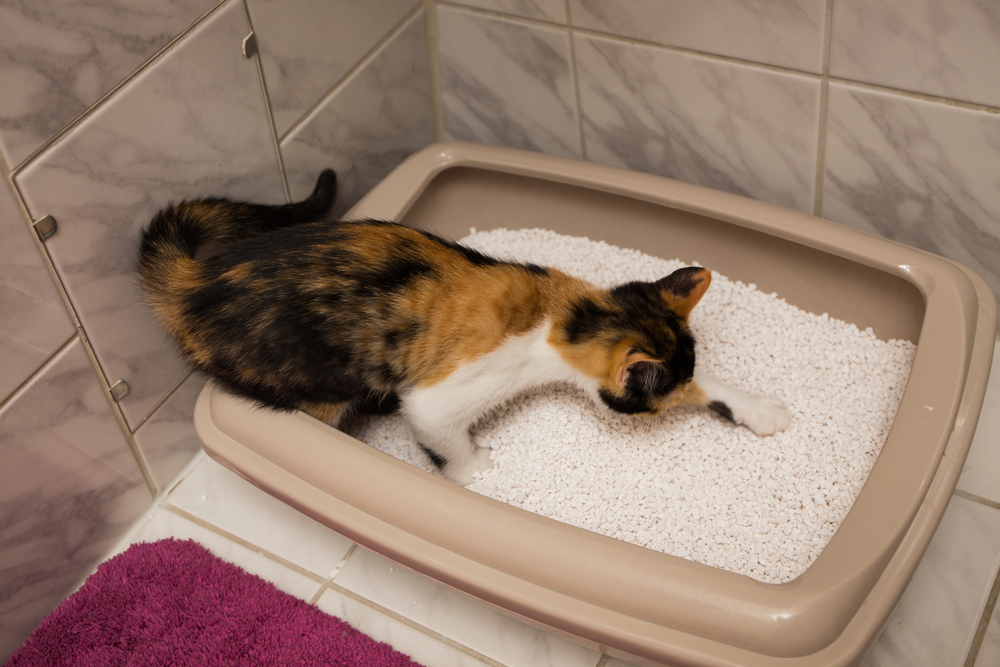
PRO-TIP: don’t practice positive reinforcement by giving your cat treats near the litter tray. You may see this suggested elsewhere, but it can be risky. Occasionally some cats develop a dangerous habit for eating litter granules, which can cause bowel blockages and ultimately be fatal. The last thing you want to do is create a strong association between the litter box and food.
5. Stay Patient
Even with a fancy automatic self-cleaning litter box, don’t expect this to be a walk in the park. Hey, if it was, you wouldn’t need a litter box at all. Whether you’re buying the litter box for your brand new pet, or transitioning an old friend to a new box, you’ll need to be prepared for this process to take a couple of weeks. Take comfort in the fact that once they’re fully litter trained, your cleaning will be hands-off for the long-term.
FAQs
How to Stop My Cat Pooping Outside the Litter Box?
Pooping outside the box is a common problem. Usually, the solution can be found by doing one or more of the following:
- Ensuring the box is promptly cleaned after use
- Using a different type of litter
- Trying a different box location
- Buying a bigger box
- Setting up an additional box in your home
If the above options don’t work, your cat may have a medical issue and we would advise you to visit a veterinarian to rule out anything serious.
Why Has My Cat Suddenly Stopped Using Their Litter Box?
If your cat has suddenly stopped using the litter box, it’s a sign they’re unhappy. This is likely due to one of the following reasons:
- A change in the litter type or location
- Difficulty entering the box (especially common in older, arthritic cats)
- A medical issue causing painful urination or defecation
- A stray cat has been using the box and ‘claimed’ it
Why Does My Cat Throw Litter Out of the Box?
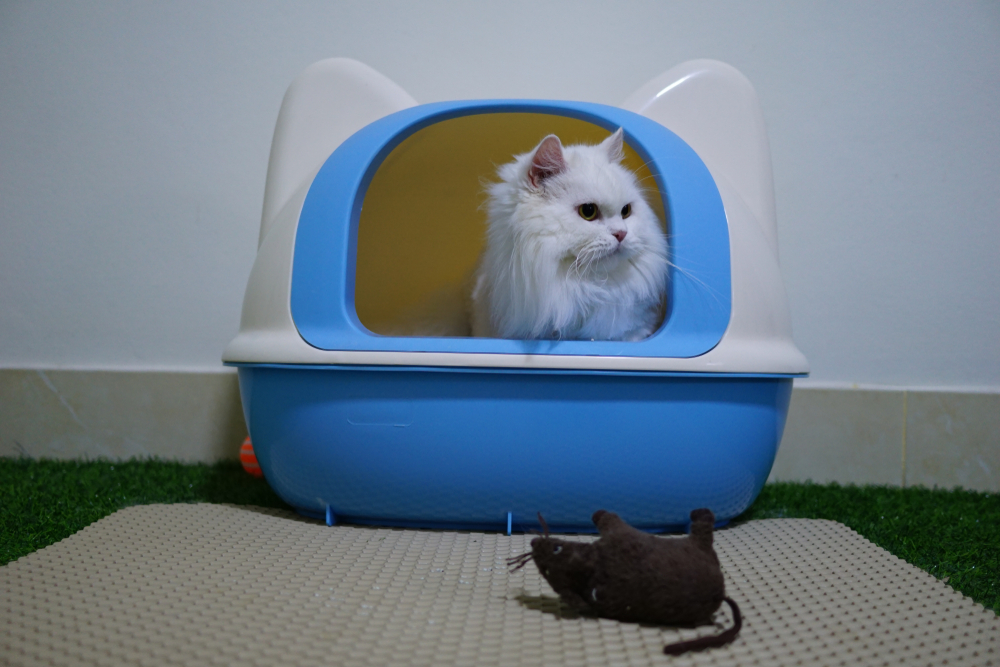
Usually, this isn’t a major problem and just requires some ‘out of the box’ thinking to solve.
It may be that your cat is too energetic for the lightweight litter you use, and a heavier alternative can often provide a quick fix. Another common scenario is that the litter box is either too small or that the sides are too low. Finally, it may be that the litter is simply tracking on your cat’s paws and being carried outside the box as they leave.
Most of these issues can be solved with self-cleaning litter boxes, which are often dome-shaped, built with raised sides, or use a specialized, non-tracking litter.
Self-Cleaning Kitty Litter: Welcome to the Future
There’s a difference between being a cat person and being that cat person. Now you know everything there is to know about self-cleaning kitty litter boxes, you have no excuse for the lingering smell of cat waste in your home (and yes, your neighbors probably did notice).
After reading our guide, you’re equipped with all the info you need to make the best choice for your cat. While transitioning your paw-fect friend to a self-cleaning litter box may take some patience, in the long run, it will save you time and effort, and help create a more pleasant home space for both you and your kitty.



